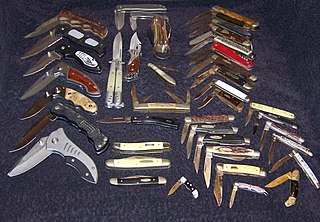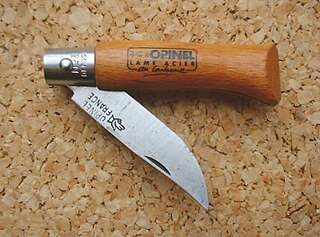
A pocketknife is a knife with one or more blades that fold into the handle. They are also known as jackknives (jack-knife), folding knives, EDC knife, or may be referred to as a penknife, though a penknife may also be a specific kind of pocketknife. A typical blade length is 5 to 15 centimetres.

The penny knife was a originally a simple 18th century utility knife with a fixed blade. It got the name penny knife because it cost 1 penny in England and America towards the end of the 18th century.

Ernest R. Emerson is an American custom knifemaker, martial artist, and edged-weapons expert. Originally an engineer and machinist in the aerospace industry, Emerson became a knifemaker by producing knives for a martial arts class and making art knives early in his knifemaking career. In the 1980s he became better known for his combat knives and popularizing a style of knife known as the Tactical-folder.
Robert Waldorf Loveless, a.k.a. Bob Loveless or RW Loveless, was an American knife maker who designed and popularized the hollowground drop point blade and the use of full tapered tangs and screw-type handle scale fasteners within the art of knifemaking. He is cited by other knifemakers and collectors as one of the most innovative custom knife makers in the world.
Kershaw Knives designs, sources and manufactures a wide range of knives, including pocketknives, sporting knives, and kitchen cutlery. Kershaw is a brand of Kai USA Ltd., a member of the KAI Group, headquartered in Tualatin, Oregon, United States.
Blade is a consumer magazine about knife collecting. The magazine is based in Appleton, Wisconsin.

Cold Steel, Inc., is an American retailer of knives/bladed tools, training weapons, swords and other martial arts edged and blunt weapons. Founded in Ventura, California, the company is currently based in Irving, Texas, after an acquisition by GSM Outdoors in 2020. Cold Steel products are manufactured worldwide, including in the United States, Japan, Taiwan, India, Italy, China, and South Africa.
The Warrior knife is a large curved blade fighting knife with a serrated back edge that was first made by Al Mar Knives and Round Eye Knife and Tool (REKAT). Part of the knife's design is credited to martial arts instructor Michael Echanis.

A higonokami is a type of folding pocket knife originating in Miki, Hyōgo Prefecture, Japan in 1896. The knife has no locking system, but is a friction folder or "penny knife", using the friction of the swivel or the pressure of the user's thumb on its iconic lever or chikiri, to prevent the knife from folding during use. The handle of the Higonokami is made of a folded over sheet of metal. The handle is stamped with the name of the maker of the knife and the steel used in the blade. A distinguishing feature is that the blade has a flat grind without a secondary bevel.

The CQC-6 or Viper Six is a handmade tactical folding knife with a tantō blade manufactured by knifemaker Ernest Emerson. Although initially reported as the sixth design in an evolution of fighting knives and the first model in the lineup of Emerson's Specwar Custom Knives, Emerson later revealed that the knife was named for SEAL Team Six. It has a chisel-ground blade of ATS-34 or 154CM stainless steel and a handle made of titanium and linen micarta. The CQC-6 is credited as the knife that popularized the concept of the tactical folding knife.

Al Mar Knives is a production knife company headquartered in Tualatin, Oregon, United States. Al Mar Knives was established in 1979 by Al Mar, and has a reputation for making tactical knives of innovative design. While headquartered in the United States, Al Mar knives were made in Seki City of Japan from 1979 to 2019.
William Wales Scagel was an American knifemaker whose style had a profound impact on the cutlery trade, influencing it for over 100 years.
The Knifemakers' Guild is an American organization, based in Richfield, Utah, made up of knifemakers to promote custom knives, encourage ethical business practices, assist with technical aspects of knife making, and to sponsor knife shows. The Guild is composed of 300 knifemaker members and several thousand collectors, writers, and other investors as honorary members.

Michael Leon Walker is an American custom knifemaker and sculptor based in Taos, New Mexico. Walker is the inventor of more than 20 different knife mechanisms including the Walker Linerlock for which he secured a trademark in 1980.
A. G. Russell was an American knife maker.
Jody Samson was a knifemaker and bladesmith from Burbank, California, who designed butterfly knives for Benchmade and the swords used in movies, including Conan the Barbarian, Conan the Destroyer, First Knight, The Mask of Zorro, Blade, Blind Fury, Batman & Robin, Batman Forever, and Streets of Fire.
Walter Wells "Blackie" Collins was an American knife maker who designed and popularized the assisted opening mechanism and various automatic knife designs within the art of knifemaking. He is cited by other knifemakers and collectors as one of the most innovative knife designers in the world and was an author and the founder of what became Blade Magazine. Collins died July 20, 2011, in a motorcycle accident near North, South Carolina.

Buster Warenski was an American custom knifemaker from Kimberly, Nevada who made "Art Knives" utilizing gold and other precious metals. Warenski is best known for making a reproduction of Tutankhamun's dagger with a forged gold blade; over 32 ounces of gold were used in the construction of the dagger, making it one of the most valuable knives made in recent years.
The Blade Show is an annual tradeshow for the cutlery industry. It is the largest event of its type in the world. The show is owned by Caribou Media Group and is hosted by Blade Magazine. The event has over 1,000 exhibitors and is the host for inductees into the annual Cutlery Hall of Fame. It also hosts the annual Blade HQ Balisong Competition, BladeSports International Cutting World Championships, Blade University, Knife of the Year Awards, and a variety of knifemaking classes and demos. The event takes place every year over the course of several days and brings in knifemakers and knife companies from all parts of world.

Zero Tolerance Knives (ZT Knives) is a knife brand of Kai USA, headquartered in Tualatin, Oregon, United States. Both Zero Tolerance and Kai USA are members of the Kai Group, a global cutlery company.










